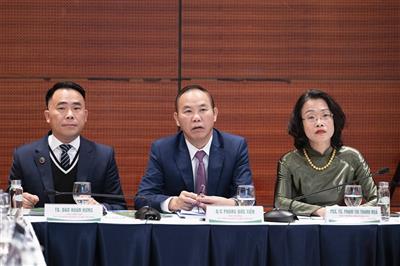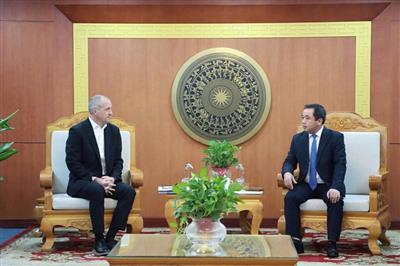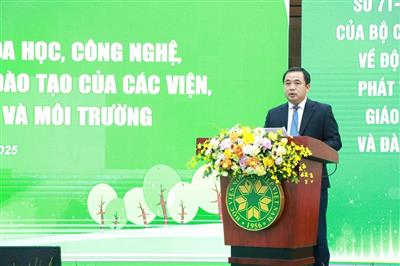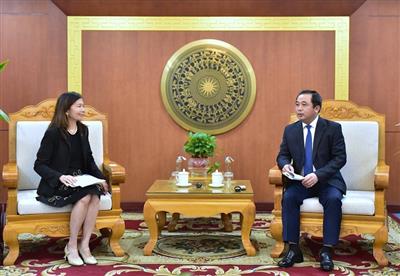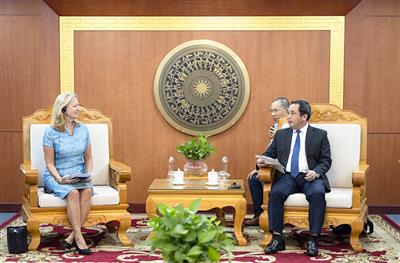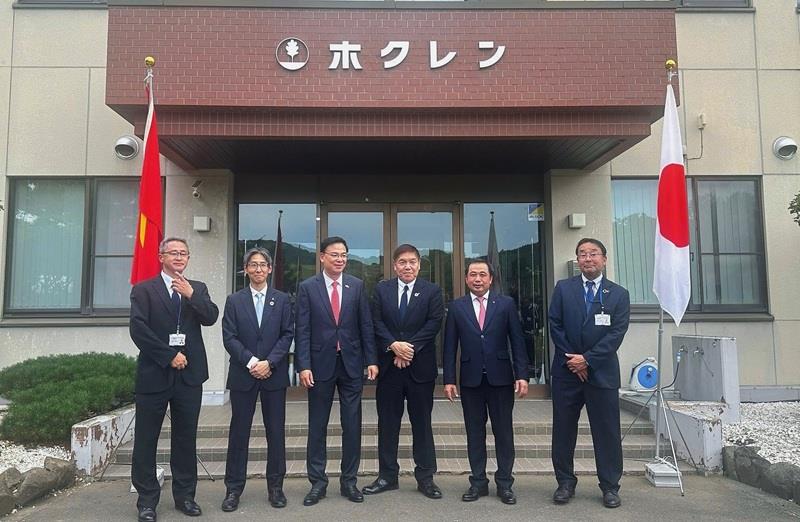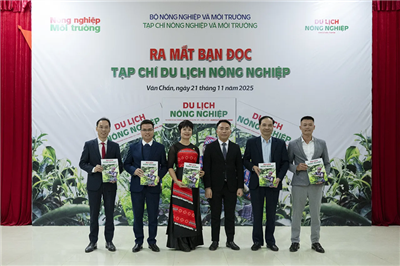
A landmark in administrative reform: Vietnam's Ministry of Agriculture and Environment leads adaptation to new two-tier local governance model
01/07/2025TN&MTStarting July 1, 2025, 34 provinces and centrally governed cities across Vietnam officially began operating under a new two-tier local government model, comprising only provincial and communal levels—effectively dissolving the district-level government structure. This historic shift marks a major milestone in Vietnam’s ongoing administrative reform agenda, aimed at streamlining governance, improving operational efficiency, and enhancing public service delivery. As one of the key ministries deeply involved in agricultural development and environmental protection, the Ministry of Agriculture and Environment (MAE) has taken a proactive approach in adapting to the new model. It has reviewed and revised policy frameworks, delegated appropriate authority, and prioritized capacity-building for grassroots-level officials. This proactive stance not only ensures continuity in sectoral governance but also lays the foundation for advancing digital transformation, green agriculture, circular econom
The shift to a two-tier local government system—comprising only the provincial and commune levels—marks a major milestone in Vietnam’s administrative reform. This transition, rooted in years of institutional research and policy development, reflects the Party’s consistent commitment to building a streamlined, efficient, and accountable state apparatus. Legal foundations were laid through Resolution No. 35/2023/UBTVQH15 and subsequent constitutional amendments, enabling 34 provinces and cities to eliminate district-level governance structures from July 1, 2025.
The nationwide rollout was formally launched on June 30, with the participation of top Party and State leaders, affirming this as a fundamental institutional reform, not merely a structural adjustment.
In this context, the Ministry of Agriculture and Environment—one of the most directly impacted ministries—acted swiftly to adapt. As a central body with deep operational reach across rural, mountainous, and coastal areas, the Ministry proactively revised legal frameworks, advanced decentralization, and enhanced grassroots capacity. It also promoted digital transformation and public service modernization in agriculture and environmental management.
This proactive approach has ensured policy continuity while creating the foundation for a more responsive, transparent, and sustainable governance model—particularly at the commune level, where critical goals such as green agriculture, circular economy, and climate adaptation are most effectively implemented.
Revising policy frameworks and management authority
In preparation for the two-tier transition, the Ministry of Agriculture and Environment launched an institutional review process to update sectoral governance mechanisms and avoid legal gaps or administrative disruption—especially in agriculture and environment, areas closely tied to the livelihoods of rural, mountainous, and coastal populations.
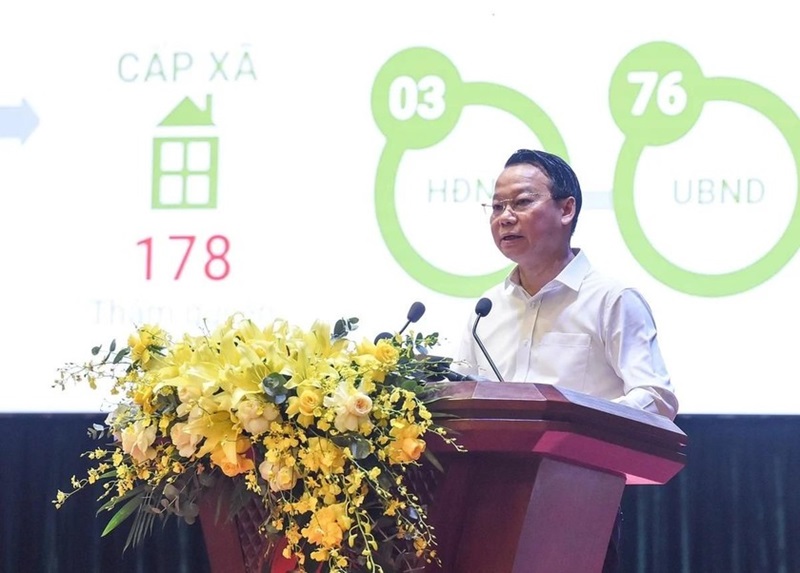
Minister of Agriculture and Environment Do Duc Duy noted that, in line with directives from the Central Government, the Ministry reviewed over 1,000 legal documents to clarify roles and responsibilities across governance levels. The review defined 141 powers under the Government and Prime Minister, 500 under the Minister of Agriculture and Environment, and more than 1,000 delegated to local authorities
In April 2025, the Ministry issued Action Plan No. 40/KH-BCĐ of the MAE Steering Committee for Administrative Reform, requiring all affiliated units to urgently review and propose revisions to legal provisions governing mandates and authorities across the new two-level government structure. This led to the issuance of three foundational decrees by the Government on June 12, 2025: Decree No. 131/2025/NĐ-CP, defining the scope of authority across local government levels in agriculture and environment; Decree No. 136/2025/NĐ-CP, detailing decentralization between the Government, Prime Minister, and MAE; Decree No. 151/2025/NĐ-CP, establishing decentralized management in land administration.
Under Decree 136, the Ministry of Agriculture and Environment proposed transferring 68 responsibilities from the Government to the Minister, and 48 from the Prime Minister. The Ministry also decentralized 166 responsibilities to provincial-level People’s Committees and 11 to commune-level authorities. These grassroots-level mandates primarily address services directly affecting the public, such as: collecting and disposing of pesticide containers, inspecting small-scale livestock operations, managing plant variety protection, and monitoring household-level animal disease outbreaks (per Annex III, Decree 131/2025/NĐ-CP).
Additionally, the Ministry of Agriculture and Environment accelerated administrative procedure reform to ease implementation at the local level. The Ministry reports that the new decrees have eliminated 987 days of cumulative processing time from a baseline of 3,175 days—an average 31% reduction. Notably, procedures under Decree 131 have seen an average time savings of 47%.
Speaking at the National Training Conference on June 15, 2025—focused on the organization of Party and government bodies under the new commune-level structure—Minister Do Duc Duy emphasized: “Decentralization must go hand in hand with enabling conditions: personnel, budget, infrastructure, and data systems. Under no circumstances should responsibilities be assigned to localities that lack sufficient capacity. This principle is essential to ensure feasibility and effectiveness in implementing the two-tier governance model.”

The Ministry of Agriculture and Environment's delegation joins the national training conference on the organization and operation of Party bodies, local governments, the Fatherland Front, and political unions at the newly established commune level
To support smooth implementation, the Ministry of Agriculture and Environment published detailed technical manuals, including standard forms, operational procedures, and intergovernmental coordination protocols. The Ministry also adopted a proactive post-audit approach to supervision—delegating authority while simultaneously enhancing accountability and oversight, in line with Prime Minister’s Directive No. 99/CD-TTg (June 27, 2025) on the two-tier model rollout.
These institutional reforms reflect the Ministry of Agriculture and Environment’s political will and administrative competence. Beyond ensuring continuity in governance, they create the structural conditions for streamlined services, digital innovation, and more responsive public administration—especially at the commune level, where proximity to citizens is greatest.
Standardizing geospatial data and updating administrative maps
One of the prerequisites for the effective rollout of the two-tier governance model on July 1, 2025, has been the timely standardization of administrative boundary data and the nationwide update of digital mapping systems. Fully aware of this critical requirement, the Ministry of Agriculture and Environment, through the Vietnam Department of Surveying, Mapping and Geographic Information, has coordinated with ministries and local authorities to synchronize cadastral data, upgrade administrative maps onto digital platforms, and ensure consistency in boundary coding and spatial governance across the entire administrative system.
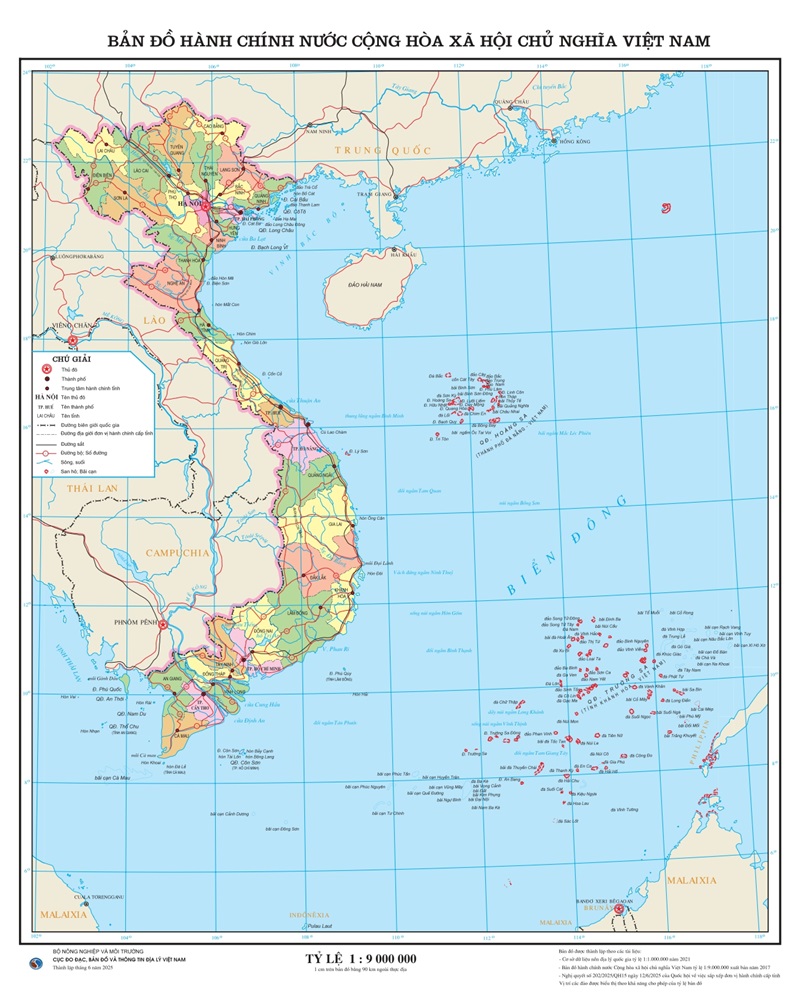
Vietnam’s administrative maps at 1:9,000,000
Following the National Assembly’s adoption of Resolution No. 202/2025/QH15—which consolidates the administrative map of Vietnam from 63 to 34 provinces and cities as of June 12, 2025— the Ministry moved swiftly to reflect this change in national mapping systems. According to the official Government Portal, by mid-June 2025, the Department of Surveying, Mapping and Geographic Information had finalized a 1:1,000,000 scale national administrative map featuring all 34 new provinces and cities, complete with standardized boundary and administrative codes. These maps are publicly available in digital formats such as PDF and GIS, supporting planning, land titling, and e-government services at the local level.
Of particular importance has been the standardization of commune-level boundaries—given the significant increase in responsibilities being devolved to the grassroots. In response to Politburo Conclusion No. 127-KL/TW dated February 28, 2025, the Department worked intensively to address any discrepancies at the commune level and prepare the necessary datasets for rapid update once relevant provincial and district restructuring resolutions were passed. Mr. Tran Duy Hanh, Director of the National Spatial Data Infrastructure Center, stated: “Our teams have worked day and night to ensure that administrative maps are promptly updated to serve government agencies, citizens, and especially grassroots-level public management.”
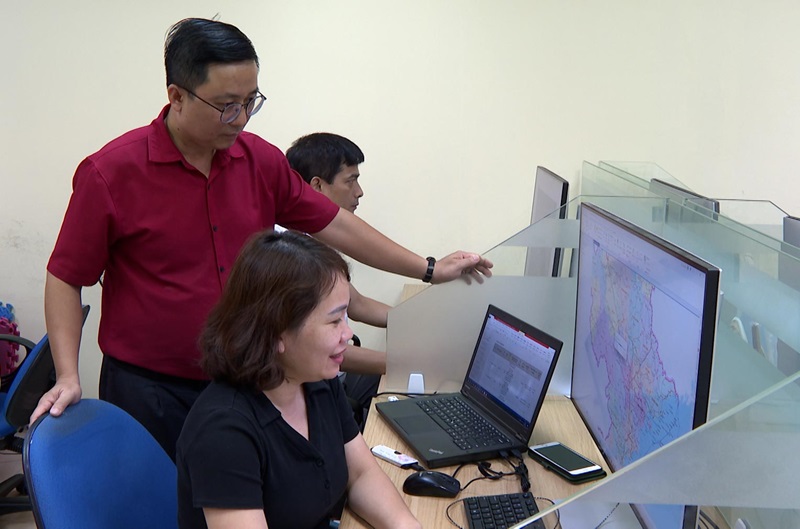
Mr. Tran Duy Hanh, Director of the National Geospatial Data Infrastructure Center, said that the agency developed over 750 map plans using the latest GIS technologies and is now ready to provide Vietnam’s administrative maps at 1:9,000,000 and 1:1,000,000 scales for public access online
To support localities in aligning cadastral records with new boundaries, the Ministry issued Circular No. 23/2025/TT-BNNMT on June 20, 2025. This document provides technical guidelines on land surveying, cadastral mapping, and adjustments following boundary changes. According to the Circular, all localities are required to complete updates to land records and administrative boundary data within 15 days of the effective date of a given restructuring resolution. This step is crucial to ensure consistency in land use planning, agricultural production, disaster risk management, and land certification—especially for commune-level development.
In parallel, the Ministry of Agriculture and Environment has accelerated the deployment of positioning data infrastructure to support digital mapping systems. Under Decision No. 728/QĐ-BNNMT (April 10, 2025), the Ministry established the National GNSS Station Network Management Center, which provides high-precision, real-time geospatial data to maintain up-to-date maps, integrate with the national spatial database, and support digital governance in agriculture and environment.
Far from being a technical exercise, the standardization of geospatial and administrative boundary data serves as a foundational pillar for Vietnam’s state management transformation. In a context where authority is being redistributed between provinces and communes, precise and harmonized geospatial data ensures transparency, legal compliance, and effectiveness in land governance, production planning, natural resource management, and climate adaptation. It also paves the way for the development of Geographic Information Systems (GIS), furthering a vision of smart, digitized, and sustainable agriculture and environmental governance.
Strengthening local cadre capacity
One of the greatest challenges in implementing the two-tier governance model lies in ensuring that commune- and ward-level staff possess sufficient professional capacity and administrative skills to fulfill newly delegated responsibilities. Acknowledging this, the Ministry of Agriculture and Environment has proactively organized a series of intensive training programs to enhance the capacity of grassroots officials—particularly through partnerships with training institutions and the practical implementation of development projects in local areas.
For example, on April 18, 2025, the Department of Agriculture and Environment of Ba Ria–Vung Tau province, in collaboration with the University of Labour and Social Affairs (Campus 2, Ho Chi Minh City), conducted a training workshop entitled “Capacity Building for Poverty Reduction Officers in 2025.” The event attracted nearly 250 commune-level officials from Ba Ria City, Chau Duc, and Xuyen Moc districts, reflecting growing attention to equipping grassroots officers with both socio-economic and rural management skills. Deputy Director of the Department, Ms. Pham Thi Na, emphasized: “The shift in mindset from one-dimensional poverty to multidimensional poverty is a crucial step—one that prioritizes not only economic support but also technical training and community-based governance at the commune level.”
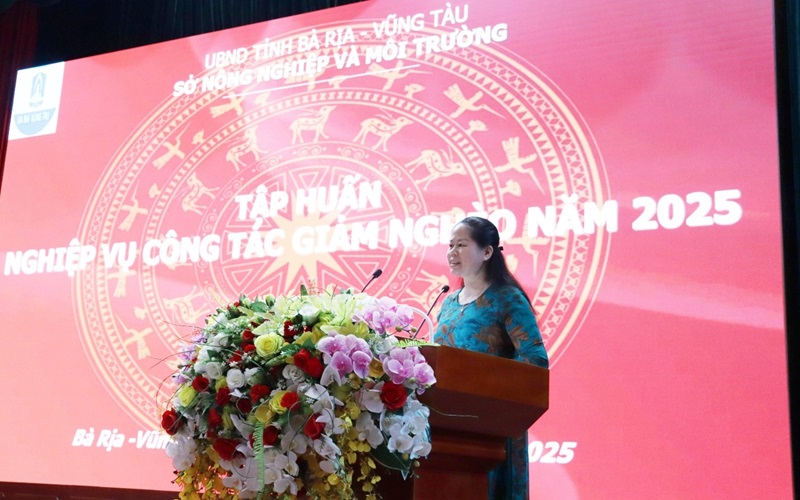
Ms. Pham Thi Na, Deputy Director of the Department of Agriculture and Environment of Ba Ria–Vung Tau, emphasized the importance of shifting from one-dimensional to multidimensional poverty reduction, highlighting the need for technical training and grassroots governance
In addition to policy training, the Ministry has supported highly practical, community-driven projects. One example is the climate change adaptation project currently underway in Son La Province (from August 2024 to December 2026), implemented across five communes in Thuan Chau District. Local officials there have facilitated 15 group training sessions on circular economy principles, reaching 372 participants. The project also trains local collaborators to implement waste treatment solutions, apply microbial technology in livestock farming, and manage biogas systems across dozens of rural households. Project officer Mr. Bui Quoc Quan stated: “All planned activities have been implemented on schedule, and the project has received close support from both government agencies and the local community.”
Moreover, during the Ministry’s early-2025 national working conferences, Minister Do Duc Duy directed all subordinate units to “promptly stabilize their internal organizational structures and finalize regulations and procedures related to human resources.” In March 2025, the Ministry established the Department of Digital Transformation under Decree No. 35/2025/NĐ-CP, which has since taken the lead in expanding training networks for grassroots-level staff to operate digital public services.
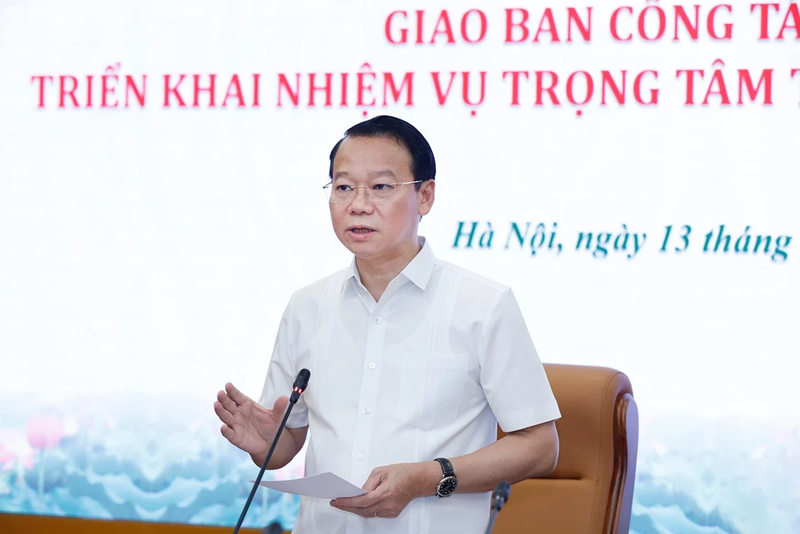
At the April review meeting, Minister Do Duc Duy candidly addressed persistent shortcomings in sectoral management, especially in licensing and administrative reform
These initiatives have helped transform grassroots officials’ understanding of policy into tangible action. Local cadres now not only grasp the relevant sectoral regulations but are also capable of applying them in managing commune-level systems, implementing support programs, overseeing environmental compliance, adapting to climate change, and participating in digital service delivery.
Through a combination of targeted training and hands-on field experience, the Ministry of Agriculture and Environment has effectively laid the groundwork for a professionalized commune-level workforce. This workforce is essential to ensuring that the two-tier governance model does not merely represent structural reform, but rather a substantial leap in grassroots administrative quality, bringing government closer to the people and delivering more effective public service.
Accelerating digital transformation and administrative reform
In the context of transitioning to a two-tier local governance model, the Ministry of Agriculture and Environment has identified digital transformation and administrative reform as two critical pillars to ensure seamless, effective, and efficient government operations—particularly at the commune level, which serves as the first point of contact for citizens and businesses.
On June 16, 2025, the Ministry issued Decision No. 2128/QĐ-BNNMT, announcing the list of administrative procedures eligible for Level-4 online public services, reaffirming its reform agenda with a clear objective: “To reduce paperwork, eliminate intermediaries, and save time and costs for citizens and enterprises.” This decision is part of a broader set of solutions aimed at enhancing transparency and gradually transitioning public services to a digital environment.
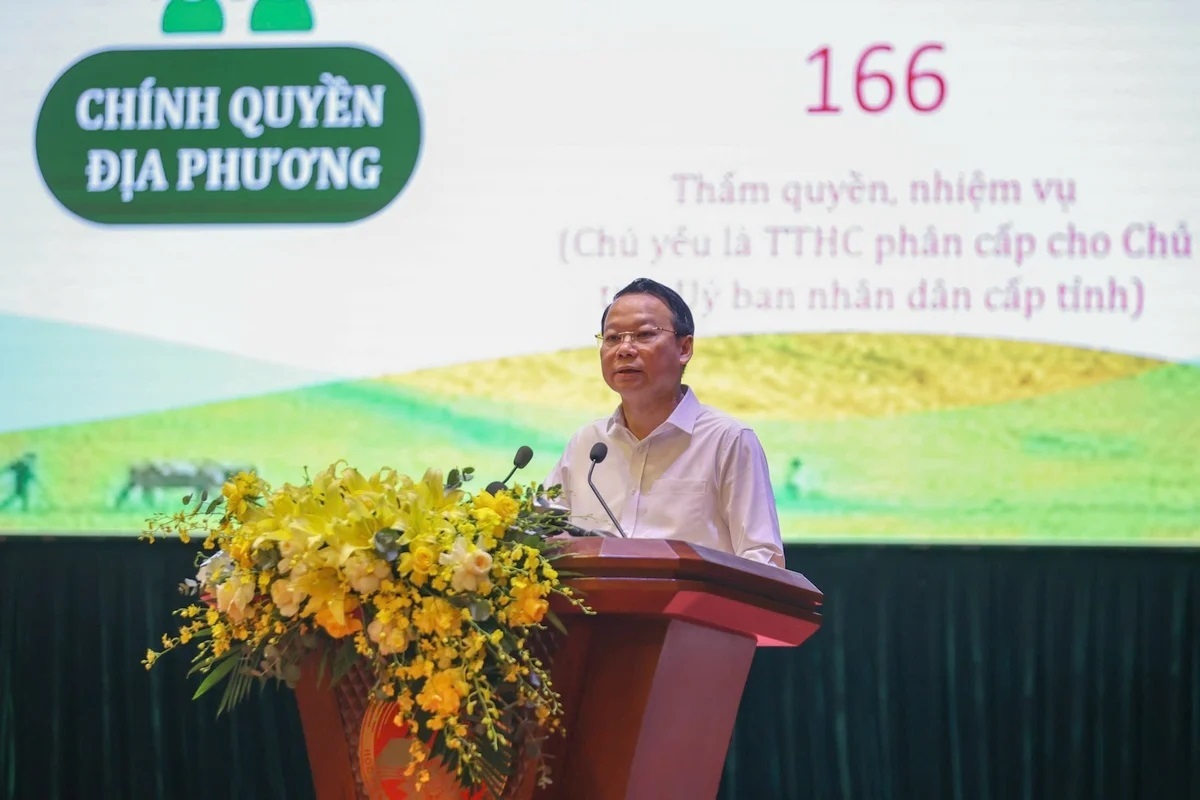
Minister Do Duc Duy emphasized that the Ministry’s decentralization strategy is grounded in clear principles: central government sets policy, while local authorities implement based on real-world conditions; technical tasks go to the Ministry, grassroots issues to local governments. Powers are transferred with corresponding resources to avoid “power without capacity.”
Simultaneously, the Ministry approved a comprehensive reform of the One-Stop Shop (OSS) system under the "single-window, interconnected-window" mechanism, which officially takes effect in July 2025. Under this plan, 14 affiliated units have been reorganized into two primary OSS hubs—one at 10 Ton That Thuyet street and the other at 2 Ngoc Ha street—streamlining the reception and processing of administrative procedures in alignment with the new two-tier model. This redesign also removes dependency on administrative boundaries, reducing travel time and social costs for applicants.
A major step forward was the enactment of Decree No. 136/2025/NĐ-CP by the Government, effective July 1, 2025, which authorizes significant decentralization of state management functions in agriculture and environment. For instance, provincial-level People's Committees have been delegated authority to appraise and approve Environmental Impact Assessment (EIA) reports for certain projects that were previously under ministerial jurisdiction. Provinces have also been granted greater control over water resources management, remote sensing applications, small-scale irrigation systems, and forest land exploitation licensing. In the land sector alone, 32 administrative procedures formerly handled at the central level have now been fully delegated to provinces, allowing for faster, localized processing.
At the commune level, several new responsibilities have also been assigned, including the collection and disposal of used pesticide packaging, the issuance of livestock farm codes for small-scale operations, and preliminary monitoring of environmentally impactful household-level production activities. This marks a substantive transfer of power, coupled with responsibility and capacity-building, empowering grassroots authorities to be more proactive in serving the public.
Regarding digital transformation, the Ministry has set ambitious goals for 2025, aiming to complete key digitization projects and prepare strategic investments for the 2025–2030 period. These include major initiatives such as the creation of agricultural land databases, rural climate databases, food traceability systems, and sectoral digital mapping platforms. At the April 2025 national review meeting, Minister Do Duc Duy emphasized: “Without real reform, procedures will remain a barrier instead of a tool to serve citizens and businesses.” He further pointed out that many current processes remain cumbersome due to fragmented and inconsistent form templates, hindering synchronized digitization. To address this, the Ministry has mandated the development of standardized form systems, coupled with automated logic-based routing, to streamline processing and reduce errors.
The Ministry is also actively piloting emerging technologies. In Dong Thap province, for example, authorities have launched a pilot project using AI-powered chatbots to help residents access information and submit applications online—especially at the commune level. This model has shown clear initial benefits: reducing workload for frontline officers while improving citizen engagement and satisfaction.
At the national level, the Ministry works in close coordination with the Government’s Administrative Reform and Decentralization Steering Committee, established by Decision No. 1417/QĐ-TTg on June 30, 2025. This ensures alignment across administrative reform, decentralization, and digital transformation under the two-tier governance framework.
These efforts reflect the Ministry's proactive and determined approach to advancing institutional reform integrated with digital governance—a vital foundation for building a citizen-centered, transparent, and efficient administration in the agriculture and environment sectors.
Mainstreaming sustainable agriculture and climate adaptation into commune-level planning
To maximize the benefits of the two-tier governance model, the Ministry of Agriculture and Environment has issued a series of legal documents guiding the effective integration of sustainable agriculture and climate adaptation policies at the commune level—the administrative tier closest to the people. A prominent example is Circular No. 19/2025/TT-BNNMT, dated June 19, 2025, in which Minister Do Duc Duy clarified the expanded mandate of commune-level Economic Departments (or Economic–Infrastructure Divisions in wards). These units are now responsible not only for agricultural planning but also for the application of science and technology, digital transformation, the implementation of e-government, and the ongoing development, management, and utilization of agricultural and environmental databases. This facilitates the integration of circular, green, and smart planning into grassroots-level development agendas.
In parallel, Circular No. 08/2025/TT-BNNMT, issued on June 17, 2025, amended Circular No. 01/2022 of the Ministry of Natural Resources and Environment. The new provisions underscore the requirement to conduct greenhouse gas inventories in key sectors—agriculture, forestry, and fisheries—at both the provincial and commune levels. This supports emission reduction targets and enables localized climate monitoring and response.
These legal instruments create a robust foundation for communes to incorporate specific goals into their local development plans, such as establishing organic farming zones, implementing biogas systems in livestock households, deploying waste-to-fertilizer technologies, and fostering green livelihoods. For example, in Son La province, over 15 community-based training sessions on circular livestock production have been held, with 372 participants. These sessions enabled the application of microbial waste treatment and biogas operation in dozens of farming households, contributing to emission reductions and environmental protection at the local level.
Moreover, the Ministry has issued technical guidelines for integrating sustainable agricultural objectives into commune-level land-use and zoning plans, in line with the 2021–2030 Strategy for Sustainable Agriculture and Rural Development. These guidelines call for a shift toward ecological, organic, circular, and low-carbon agricultural models. Local authorities are instructed to develop spatial plans that incorporate emission reduction, water resource protection, and biodiversity conservation, while also utilizing agricultural climate services (NFCS – National Framework of Climate Services), which the Ministry of Agriculture and Environment is currently piloting at the grassroots level to strengthen forecasting and early warning capacity.
To ensure synchronized implementation, the Ministry released Circular No. 13/2025/TT-BNNMT on June 19, 2025, delineating the responsibilities between provincial and commune-level specialized agencies in rural development, cooperative economics, and poverty reduction. This regulatory clarity lays the groundwork for implementing green livelihood models in alignment with sustainable rural commune planning.
Taken together, these frameworks are shaping a cohesive system of commune-level governance: from climate assessments and emissions inventories to green land-use planning and digitalized execution via technology adoption and community-based approaches. This methodology aligns closely with the spirit of the two-tier administrative reform and actively supports the development of a resilient, climate-smart, and environmentally sustainable agricultural model—in line with Vietnam’s international commitments on climate action and sustainable development.
Strategic vision and international outlook
The official implementation of the two-tier local government model from July 1, 2025, represents not only a large-scale domestic administrative reform but also opens a new horizon for shaping a modern system of agricultural and environmental governance aligned with global standards. In the context of Vietnam’s proactive international integration and green growth agenda, this model lays the groundwork for a “people-centered – effective – transparent” management cycle, enhancing public service delivery in rural areas and building confidence among international investors.
As the lead agency responsible for implementing many of the Sustainable Development Goals (SDGs), the Ministry of Agriculture and Environment is leveraging this institutional reform to restructure governance at both central and local levels. This includes integrating the management of agriculture, environment, land, and climate into a streamlined administrative framework. The two-tier model helps narrow the gap between policy formulation and implementation, enabling large-scale programs—such as ecological agricultural transformation, concentrated raw material zone development, climate forecasting systems for agriculture, and emissions quota allocation—to be rolled out in a flexible and synchronized manner from provinces to communes. This is essential to realizing Vietnam’s commitments under COP28 and fulfilling obligations under new-generation free trade agreements.
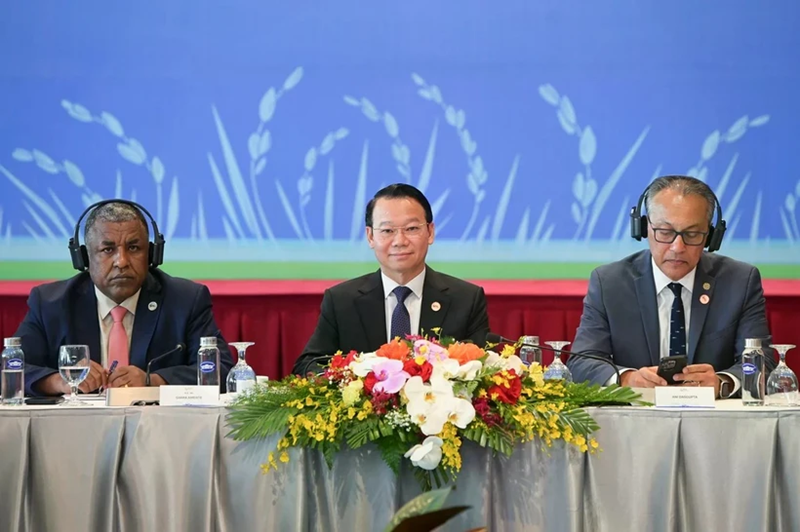
Minister of Agriculture and Environment Do Duc Duy chaired the ministerial discussion session at the P4G Summit
At the national level, the Ministry is developing mechanisms for real-time policy evaluation through updated digital maps and spatial data systems. These tools enable evidence-based policymaking and ensure that agricultural and environmental planning is rooted in science, linked with digital governance and disaster risk management. They also position Vietnam to respond more effectively to climate change and assume a proactive international role in low-carbon agriculture, circular economy development, and biodiversity conservation.
Strategically, the Ministry envisions itself as a model of modern governance in agriculture and environment—built on three pillars: intelligence, transparency, and efficiency. Minister Do Duc Duy has repeatedly emphasized that effective governance at the commune level is the “golden link” in the public administration chain—where national policies are transformed into concrete actions, where people’s rights are ensured, and where investors first interact with Vietnam’s agricultural, environmental, land, and climate sectors.
For the international community, Vietnam’s two-tier government reform signals a consistent commitment to a “facilitative state and sustainable development”. The new model provides both legal and technical frameworks to implement global standards such as the FAO Voluntary Guidelines on the Responsible Governance of Tenure (VGGT), sustainable forest management under FSC certification, agricultural traceability, and decarbonization roadmaps in agri-supply chains. This enhances Vietnam’s credibility as a reliable destination for investment in high-tech agriculture, biomass energy, carbon credit markets, and sustainable agri-value chains.
By advancing a structural administrative reform, the Ministry of Agriculture and Environment is cultivating a new ecosystem of governance—where the two-tier government model serves as a catalyst for innovation, green transformation, and global connectivity. This lays the foundation for Vietnam’s next phase of development: a green, transparent, and globally integrated agricultural and environmental public administration.
Ngoc Huyen


